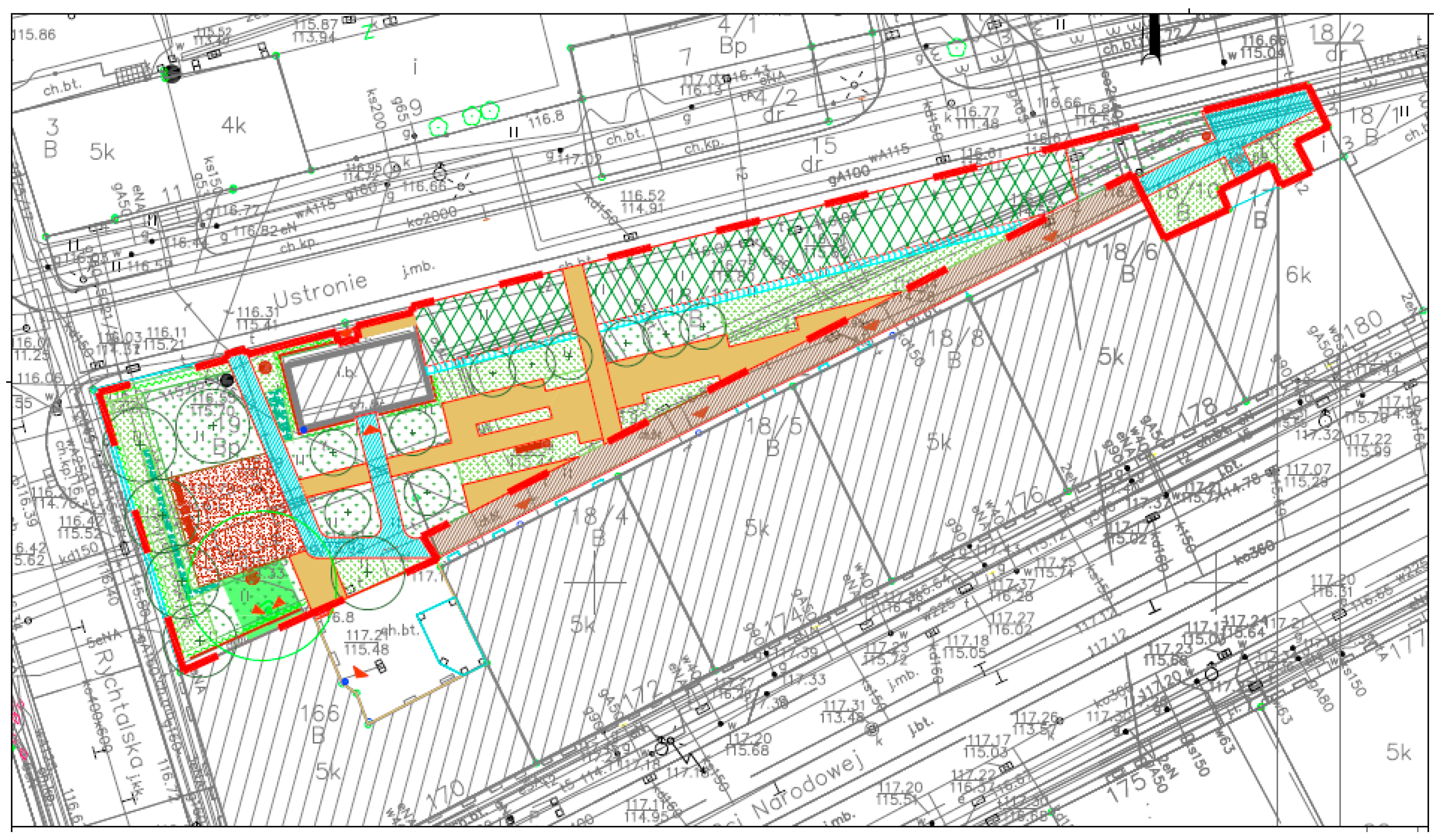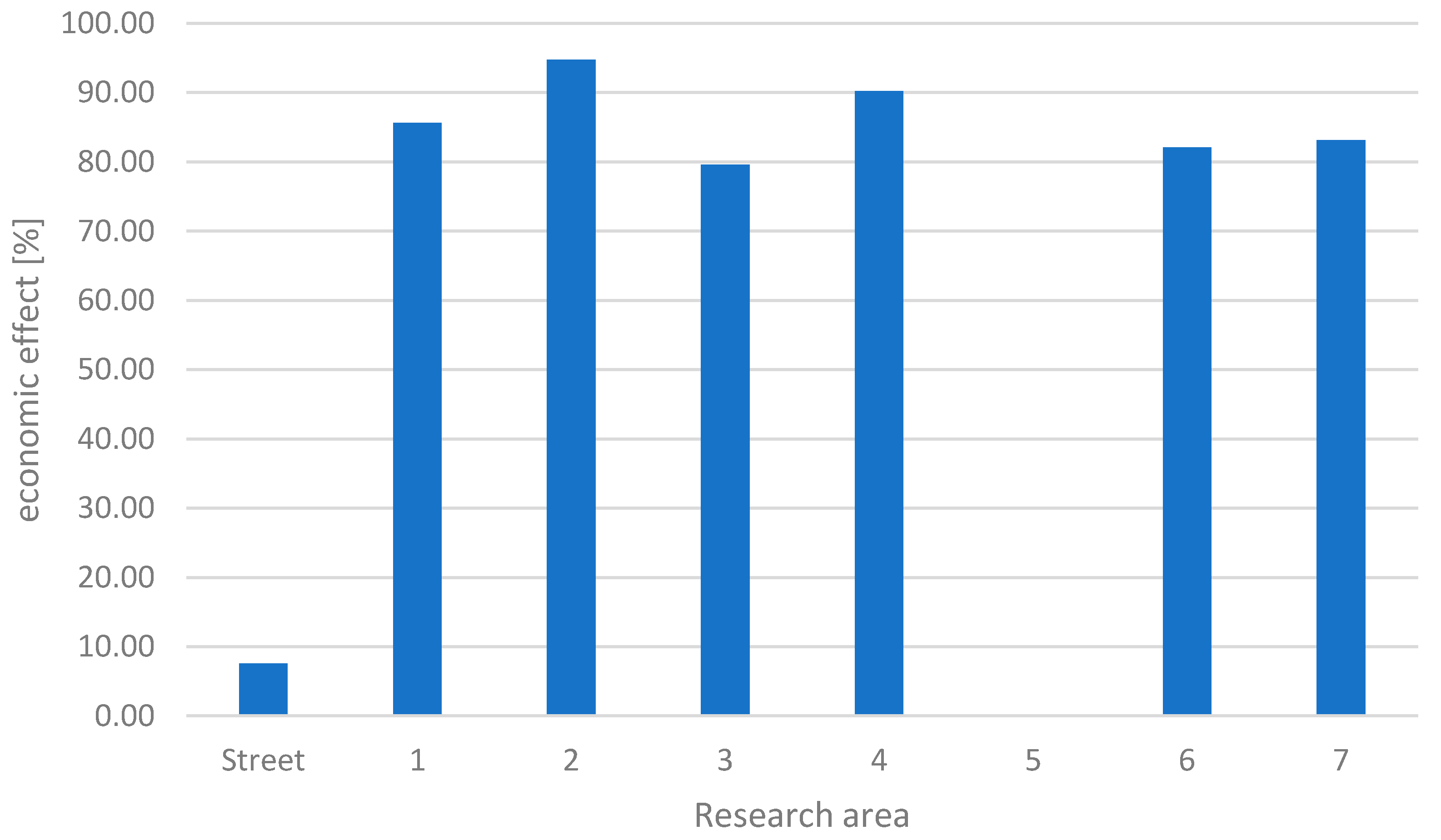Water Retention in Nature-Based Solutions—Assessment of Potential Economic Effects for Local Social Groups
Abstract
:1. Introduction
- The protection and conservation of existing elements of blue–green infrastructure, as well as the introduction of proper blue–green infrastructure designs into areas dominated by dense development;
- Most activities in the area of the thermo-modernization of buildings;
- The replacement of impervious surfaces with permeable surfaces;
- Recycling and circular economy principles’ introduction.
- The introduction of shelterbelts (vegetative environmental buffers) around industrial plants;
- The introduction of rainwater management systems in courtyards;
- Activities that can be implemented in households, e.g., composting, greywater use and rainwater collection.
2. Materials and Methods
2.1. Site Description

| Legend | |
 | Existing buildings (roof surface) |
 | An existing sidewalk of cobblestones |
 | Gravel surface |
 | Surface—wood chips |
 | Surface—EcoGrid |
 | Retention basin |
 | Trees and shrubs |
 | Groundcover vegetation |
 | Lawn |
 | Animal habitat area |
 | Rain garden |
2.2. Data Analysis
- is the catchment area (m2);
- is the surface runoff coefficient (-) (Table 1);
- is the annual amount of precipitation, 699 (mm) (source: calculated per year, i.e., from 01/09/2018 to 31/08/2019—compiled by Prof. Ewa Burszta-Adamiak).
- (1)
- Without water retention devices from impervious surfaces—0.50 PLN/m3/year;
- (2)
- With infrastructure for the water retention from impervious surfaces with a capacity:
- (a)
- Up to 10% of the annual runoff from impervious areas—0.30 PLN/m3/year;
- (b)
- 10% to 30% of the annual runoff from impervious areas—0.15 PLN/m3/year;
- (c)
- Over 30% of the annual runoff from impervious areas—0.05 PLN/m3/year.
- —the costs of draining rainwater using the sewage system after implementing the NBS,;
- —government tax after implementing the NBS, ;
- —the costs of draining rainwater using the sewage system before implementing the NBS, ;
- —the government tax before implementing the NBS, .
3. Results
4. Conclusions and Discussion
Author Contributions
Funding
Acknowledgments
Conflicts of Interest
References
- Wang, T. Global number of natural disasters events 2000–2019. Statista 2020, 22–25. [Google Scholar]
- NASA. Moderate Resolution Imaging Spectroradiometer (MODIS/TERRA); NASA Official: Moffett Field, CA, USA, 2020.
- Advisor. Global Views on the Environment -2018; IPSOS Global: Paris, France, 2018. [Google Scholar]
- Zölch, T.; Henze, L.; Keilholz, P.; Pauleit, S. Regulating urban surface runoff through nature-based solutions-An assessment at the micro-scale. Environ. Res. 2017, 157, 135–144. [Google Scholar] [CrossRef] [PubMed]
- Flörke, M.; Schneider, C.; McDonald, R.I. Water competition between cities and agriculture driven by climate change and urban growth. Nat. Sustain. 2018, 1, 51–58. [Google Scholar] [CrossRef]
- Zwoździak, J.; Kwiecińska, K.; Szałata, L. Nature-Based Solutions Handbook; Wydawnictwo EDYTOR: Wroclaw, Poland, 2018; ISBN 978-83-64553-34-9. [Google Scholar]
- Collentine, D.; Futter, M. Realising the potential of natural water retention measures in catchment flood management: Trade-offs and matching interests. J. Flood Risk Manag. 2016, 11, 76–84. [Google Scholar] [CrossRef]
- Kabisch, N.; Korn, H.; Stadler, J.; Bonn, A. Nature-Based Solutions to Climate Change Adaptation in Urban Areas; Linkages Between Science, Policy and Practice; Springer Science and Business Media LLC: Berlin, Germany, 2017; pp. 1–11. [Google Scholar]
- Ahern, J.; Cilliers, S.S.; Niemelä, J. The concept of ecosystem services in adaptive urban planning and design: A framework for supporting innovation. Landsc. Urban. Plan. 2014, 125, 254–259. [Google Scholar] [CrossRef] [Green Version]
- Connop, S.; Vandergert, P.; Eisenberg, B.; Collier, M.; Nash, C.; Clough, J.; Newport, D. Renaturing cities using a regionally-focused biodiversity-led multifunctional benefits approach to urban green infrastructure. Environ. Sci. Policy 2016, 62, 99–111. [Google Scholar] [CrossRef] [Green Version]
- Faivre, N.; Fritz, M.; Freitas, T.; De Boissezon, B.; Vandewoestijne, S. Nature-Based Solutions in the EU: Innovating with nature to address social, economic and environmental challenges. Environ. Res. 2017, 159, 509–518. [Google Scholar] [CrossRef] [PubMed]
- Xie, L.; Bulkeley, H. Nature-based solutions for urban biodiversity governance. Environ. Sci. Policy 2020, 110, 77–87. [Google Scholar] [CrossRef]
- Enzi, V.; Cameron, B.; Dezsényi, P.; Gedge, D.; Mann, G.; Pitha, U. Nature-based solutions and buildings-The power of surfaces to help cities adapt to climate change and to deliver biodiversity. Nat.-Based Solut. Clim. Chang. Adaptat. Urban. Areas 2017, 159–183. [Google Scholar] [CrossRef] [Green Version]
- United Nations. Nature-based Solutions for Water. In UN World Water Development Report; UNESCO World Water Assessment Programme: Geneva, Switzerland, 2019. [Google Scholar]
- Smith, M.; Barchiesi, S.S. Environment as infrastructure: Resilience to climate change impacts of water through investments in nature. Int. Union Conserv. Nat. IUCN 2009, 2, 10. [Google Scholar]
- Vallecillo, S.; Polce, C.; Barbosa, A.; Castillo, C.P.; Vandecasteele, I.; Rusch, G.M.; Maes, J. Spatial alternatives for Green Infrastructure planning across the EU: An ecosystem service perspective. Landsc. Urban. Plan. 2018, 174, 41–54. [Google Scholar] [CrossRef]
- Raymond, C.; Christopher, M.; Frantzeskaki, N.; Kabisch, N.; Berry, P.; Breil, M.; Nita, M.; Mihai, R.; Geneletti, D.; Calfapietra, C. A framework for assessing and implementing the co-benefits of nature-based solutions in urban areas. Environ. Sci. Policy 2017, 77, 15–24. [Google Scholar] [CrossRef]
- Liquete, C.; Udias, A.; Conte, G.; Grizzetti, B.; Masi, F. Integrated valuation of a nature-based solution for water pollution control. Highlighting hidden benefits. Ecosyst. Serv. 2016, 22, 392–401. [Google Scholar] [CrossRef]
- Jones, N.; Shaw, S.; Ross, H.; Witt, K.; Pinner, B. The study of human values in understanding and managing social-ecological systems. Ecol. Soc. 2016, 21, 15. [Google Scholar] [CrossRef] [Green Version]
- Frantzeskaki, N. Seven lessons for planning nature-based solutions in cities. Environ. Sci. Policy 2019, 93, 101–111. [Google Scholar] [CrossRef]
- Wallace, K.J.; Wagner, C.; Smith, M.J. Eliciting human values for conservation planning and decisions: A global issue. J. Environ. Manag. 2016, 170, 160–168. [Google Scholar] [CrossRef] [PubMed] [Green Version]
- Environment Minister. Water Law. Item 1566. J. Laws 2017 (Warsaw) 2017. Available online: https://isap.sejm.gov.pl/isap.nsf/download.xsp/WDU20170001566/U/D20171566Lj.pdf (accessed on 9 October 2020).
- Environment Minister. On unit rates for water services. Item 2502. J. Laws 2017 (Warsaw) 2017. Available online: https://isap.sejm.gov.pl/isap.nsf/download.xsp/WDU20170002502/O/D20172502.pdf (accessed on 9 October 2020).


| Type | The Value of the Runoff Coefficient Ψ |
|---|---|
| Impervious surface | Ψ = 0.90–1.00 |
| Semi-impervious surface | Ψ = 0.80–0.90 |
| Biologically active surface | Ψ = 0.00–0.10 |
| The actual state—before implementing the NBS | |||||||
| Research areas | Impervious surface[g] (m2) | Roof surface[g] (m2) | Semi-impervious surface[h] (m2) | Biologically active surface[j] (m2) | The amount of drained rainwater using the sewage system [m3/year] | Costs of draining rainwater, EUR[k]/year | Government tax, EUR[k]/year |
| Street | 15,348.00 | 0.00 | 0.00 | 0.00 | 10,728.25 | 5411.81 | 1192.03 [1] |
| 1 | 1506.80 | 1680.00 | 0.00 | 0.00 | 2227.57 | 1123.69 | 247.51 [1] |
| 2 | 1499.60 | 2368.40 | 0.00 | 0.00 | 2703.73 | 1363.88 | 300.41 [1] |
| 3 | 6718.80 | 5643.00 | 0.00 | 0.00 | 8640.90 | 4358.85 | 960.10 [1] |
| 4 | 6691.60 | 9067.20 | 0.00 | 0.00 | 11,015.40 | 5556.66 | 1223.93 [1] |
| 5 | 88.80 | 0.00 | 0.00 | 1851.20 | 62.07 | 31.31 | 6.90 [1] |
| 6 | 3170.00 | 2016.80 | 0.00 | 0.00 | 3625.57 | 1828.90 | 402.84 [1] |
| 7 | 3169.20 | 2668.40 | 0.00 | 0.00 | 4080.48 | 2058.38 | 453.39 [1] |
| Projected state—after implementing NBS | |||||||
| Street | 14,183.44 | 0.00 | 607.00 | 554.56 | 9914.22 | 5001.18 | 1101.58 [1] |
| 1 | 410.80 | 1680.00 | 169.60 | 926.40 | 381.99 | 192.69 | 4.24 [2c] |
| 2 | 176.00 | 2368.40 | 83.60 | 1240.00 | 169.77 | 85.64 | 1.89 [2c] |
| 3 | 2630.80 | 5643.00 | 476.80 | 3612.00 | 2105.56 | 1062.14 | 23.40 [2c] |
| 4 | 1114.40 | 9067.20 | 910.00 | 4667.20 | 1287.84 | 649.64 | 14.31 [2c] |
| 5 | 88.80 | 0.00 | 0.00 | 1851.20 | 62.07 | 31.31 | 0.69 [2c] |
| 6 | 1044.80 | 2016.80 | 83.20 | 2042.00 | 776.84 | 391.87 | 8.63 [2c] |
| 7 | 1003.60 | 2668.40 | 214.40 | 1951.20 | 821.41 | 414.36 | 9.13 [2c] |
| Research Areas | Amount of Total Reduced Operational Cost, EUR/Year | Economic Effect, % | Amount of Total Reduced Operational Cost per Unit Area, EUR/m2/Year |
|---|---|---|---|
| Street | 501.08 | 7.59 | 0.03 |
| 1 | 1174.26 | 85.64 | 0.37 |
| 2 | 1576.77 | 94.74 | 0.41 |
| 3 | 4233.42 | 79.59 | 0.34 |
| 4 | 6116.64 | 90.21 | 0.39 |
| 5 | 0.00 | 0.00 | 0.00 |
| 6 | 1831.24 | 82.05 | 0.35 |
| 7 | 2088.28 | 83.14 | 0.36 |
Publisher’s Note: MDPI stays neutral with regard to jurisdictional claims in published maps and institutional affiliations. |
© 2020 by the authors. Licensee MDPI, Basel, Switzerland. This article is an open access article distributed under the terms and conditions of the Creative Commons Attribution (CC BY) license (http://creativecommons.org/licenses/by/4.0/).
Share and Cite
Jerzy, Z.; Łukasz, S.; Anna, Z.; Kornelia, K.; Maksym, B. Water Retention in Nature-Based Solutions—Assessment of Potential Economic Effects for Local Social Groups. Water 2020, 12, 3347. https://doi.org/10.3390/w12123347
Jerzy Z, Łukasz S, Anna Z, Kornelia K, Maksym B. Water Retention in Nature-Based Solutions—Assessment of Potential Economic Effects for Local Social Groups. Water. 2020; 12(12):3347. https://doi.org/10.3390/w12123347
Chicago/Turabian StyleJerzy, Zwoździak, Szałata Łukasz, Zwoździak Anna, Kwiecińska Kornelia, and Byelyayev Maksym. 2020. "Water Retention in Nature-Based Solutions—Assessment of Potential Economic Effects for Local Social Groups" Water 12, no. 12: 3347. https://doi.org/10.3390/w12123347
APA StyleJerzy, Z., Łukasz, S., Anna, Z., Kornelia, K., & Maksym, B. (2020). Water Retention in Nature-Based Solutions—Assessment of Potential Economic Effects for Local Social Groups. Water, 12(12), 3347. https://doi.org/10.3390/w12123347





